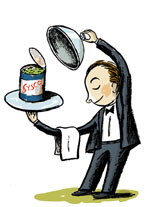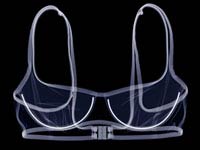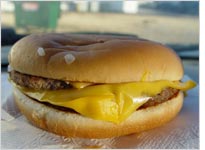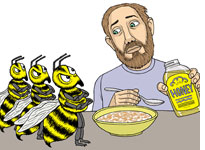By Ulrich Boser
Listen to the MP3 audio version of this story here, or sign up for Slate's free daily podcast on iTunes.

A hot dog from Yankee Stadium. Potato latkes from the Four Seasons in Manhattan. Sirloin steak at Applebee's. The jumbo cheeseburger at the University of Iowa Hospital. While it would seem these menu items have nothing in common, they're all from Sysco, a Houston-based food wholesaler. This top food supplier serves nearly 400,000 American eating establishments, from fast-food joints like Wendy's, to five-star eating establishments like Robert Redford's Tree Room Restaurant, to mom-and-pop diners like the Chatterbox Drive-In, to ethnic restaurants like Meskerem Ethiopian restaurant. Even Gitmo dishes out food from Sysco. Should you worry that one source dominates so much of what you eat?
Like any retailer, chefs need wholesalers that distribute goods cheaply and efficiently, and Sysco's 400,000-plus item catalog conveniently sells everything a cook needs to run an eating establishment. A little more than half of their products are brand names like Parkay and Lucky Charms. The rest are Sysco-packaged items like 25-pound bags of rice, half-gallons of salsa, boxes of plastic gloves, beer mugs, dish-washing detergent, not to mention 1,900 different fresh and frozen chicken products. Whatever a cook orders is delivered straight to the kitchen door at bottom-barrel prices: One Sysco invoice I got my hands on has a 25-pound bag of Uncle Ben's Converted Rice selling for $20.95, or about 84 cents a pound, while a 1-pound box bought through Amazon Grocery costs $2.09.
All of that seems relatively innocuous—restaurants need to make a profit, after all. But Sysco also hawks pre-packaged food. While chefs have long relied on shortcuts like freezing and using canned goods like beans and tomatoes, it's entirely different to pass off one of Sysco's thousands of ready-made items—ground beef burritos, vegan tortellini, quiche Lorraine pie, tiramisu cake—as homemade.
The ingredients alone on some of the pre-made items are enough to make a restaurant-goer swear off eating out. The breaded cheese chicken breast, for instance, contains monocalcium phosphates, sorbic acid preservatives, and oleoresin in turmeric. The Serve Smart Chicken is particularly frightening. While it looks natural, it consists of parts of other chicken breasts mashed together into a single, chicken-breastlike block. As the company notes on its Web site, our "unique 3-D technology gives you the look and texture of a solid muscle chicken breast, at a fraction of the cost. … Available in four great flavors: teriyaki, BBQ, fajita and original." What Smart Chicken tastes like, I'd rather not know.
Restaurants make a mint from serving these pre-prepped foods, since the meals can be purchased in bulk and stored in a freezer for months. A box of 36, 4-ounce chicken Kievs, for instance, can be kept in an icebox for up to 180 days. And the savings from labor costs are considerable. Each reheated Angus country fried steak will bring in almost $5 in profits. In the words of Sysco, these meals require nothing more than the ability to "heat, assemble, and serve."
It comes as little surprise that institutions like hospitals, universities, and military bases flock to Sysco's pre-cooked foods. But well-regarded bistros and pubs have also begun to offer such items to save time and money. Recently, New York magazine reported that Thomas Keller uses frozen Sysco fries at his Bouchon bistros. (While a company spokeswoman wouldn't confirm the brand, she confirmed the use of frozen fries.) Mickey Mantle's Restaurant, an upscale sports bar, serves Sysco's pre-made soups, like Manhattan clam chowder and vegetarian black bean. And then there's Edgar's restaurant at Belhurst Castle, which has won numerous awards of excellence from Wine Spectator magazine. There, the kitchen takes Sysco's Imperial Towering Chocolate Cake out of the box, lets it defrost, and then sprinkles it with fresh raspberries before serving it to diners. "We've had a lot of success with that cake," executive chef Casey Belile says. The Edgar's menu, of course, does not list the dessert as a Sysco pre-made cake, but it does charge $8.95 for the experience.
The company has a long history of championing frozen foods. Sysco founder John Baugh has been quoted as saying, "frozen foods taste better than anything I could grow in my garden." He started the company in 1969 when he saw an opening in the food services marketplace for a large, national distributor that would beat out local competitors through its sheer size. At the time, Baugh owned a small frozen-food company in Houston, and he convinced eight other regional food distributors to join forces to form a national conglomerate. Within a year of its start, Sysco posted more than $100 million in sales, and for the next 30 years, snapped up more than 150 local food distributors, becoming the largest in the nation. The company is about 50 percent larger than its next-largest competitor and five times bigger than the third-largest player; its boxes and cans are now as common in restaurant kitchens as salt and flour. A very partial listing of its better-known customers can be found here.
Some obvious food trends have helped Sysco's rise to Wal-Mart-like dominance. In 1970, households spent 34 percent of their food budget on dining out, compared to almost 50 percent today. And as small, local farms have closed down to make way for strip malls, restaurants increasingly depend on regional and national food processors to supply them with basic ingredients. While Sysco has smartly capitalized on all of this as the middleman between individual food distributors and the kitchen door, it's also earned the ire of gourmets, who portray the company as a leviathan that destroys local economies—and good taste.
But many quality restaurants, like Tree Room, use Sysco responsibly—shying away from pre-made items they can disguise as their own. Bardia Ferdowski of Bardia's New Orleans Café in Washington, D.C., purchases only raw and unprocessed Sysco products such as flour, potatoes, and beef, and receives frequent deliveries so that ingredients are as fresh as possible. For its part, Sysco has also been upping the quality of some of its offerings. It now distributes more locally grown meats and produce, and teams up with companies like artisanal cheesemonger Murray's to deliver specialty foods. Chef Tom Hosack of Hudson's at the Heathman Lodge in Vancouver, Wash., for instance, buys most of his greens through Sysco, and they're almost all regionally grown.
And not every cook has the time—or the money—to spend every afternoon foraging for fresh heirloom tomatoes at the local farmer's market. Nor do they need to. Many of Sysco's products—the meat, the vegetables, the fruits—are not that different than what you'll find at your local supermarket. But no restaurant diner should pay a chef to defrost and heat. Cooks are called cooks for a reason.
Original here












